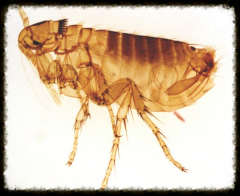common being the cat flea and the dog flea.
They are 1-6mm in length and black or brown in colour. The cat flea is far the more common species, with this parasite being found upon both dogs & cats. They are usually cat fleas that their pet has deposited on the ground. All fleas are blood-sucking parasites and they need a living host in order to survive.
Fleas are wingless insects with a laterally flattened body, hairy with hooks on their legs to move easily through and to grip onto the fur of their hosts. They have very powerful hind legs that have a rubber-like resilin in their joints. When they compress these legs and release them, they are catapulted into the air, by as much as 20cms up & 35cm horizontally-150 times their own length! That is comparable a 6 foot man jumping 900 feet.
The life cycle of the flea is composed of the egg, larval, pupal and adult stages. Cycle length ranges from several weeks to several months and is largely dependent upon environmental conditions.
Fleas lay between four and forty eggs a day, with the highest concentrations of laying occurring within the last few days of the female's life. Unlike the eggs of most parasites, flea eggs are not sticky and usually fall to the ground immediately upon being laid. Flea eggs hatch into larvae within one to 12 days. Flea larvae are approximately 1/4-inch long and are semi-transparent white in color. The larval stage lasts from four to 18 days, after which larvae spin silken cocoons and enter the pupal stage. The pupal stage may be complete within three days, or it can last as long as one year.
Adult fleas begin searching for food when they emerge from the pupal stage. While fleas are noted for their jumping abilities, they will remain stationery when a suitable host is located. Females begin laying eggs within 48 hours of the first feed, thus beginning the life cycle again.
Cold environments cause eggs to perish before hatching. Humidity below 50 per cent will kill larvae. Fleas in the pupal stage will become adults more rapidly in the presence of warmth and high humidity.
Identifying a flea infestation can often be simple, while eradicating their population proves much more difficult. Observe your pet's behavior as a first step: if your pet is scratching excessively, you should examine his or her fur. Infested animals have reddened skin and may lose hair. The hind quarters of dogs and the head and neck of cats are most commonly targeted.
If insects can be seen visibly moving between hairs or if red and black droppings are present on your pet's skin, contact your veterinarian to discuss flea treatment options. If no insects are present but scratching persists, your veterinarian can also help identify other skin conditions which may be causing your pet's discomfort.
Fleas are approximately 1/8-inch in length. Their bodies are flat and without wings. Their six legs are long and assist them in jumping great distances. Locating fleas in your pet's fur does not reveal the true extent of the infestation. Adult fleas which prey on pets comprise only five per cent of the total flea population. Eggs, larvae and pupae will also thrive within your home or yard and are difficult to see. Flea larvae are dirty-white in colour and measure less than 1/4-inch in length.
Upon identifying an infestation, clean your home thoroughly and bathe your pet with specially-formulated shampoos. Linens and pet beds should be washed. Contact Redbridge Environmental Solutions on 0800 107 6064 to discuss extermination options and preparatory steps.
Walking around your home in white socks will help you notice adult fleas as they will stand out against the white sock. White handkerchiefs also work well as the fleas may jump on them for easier viewing.

